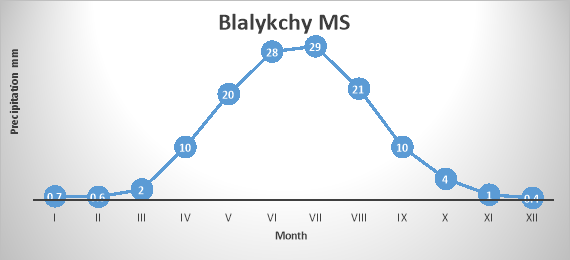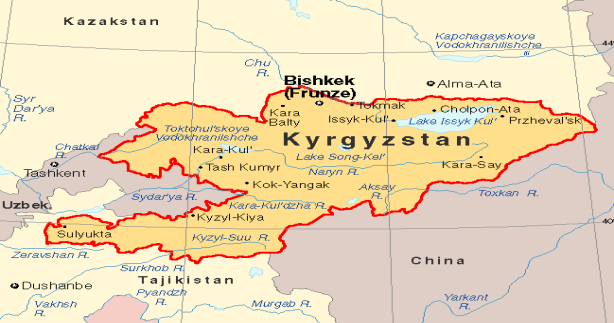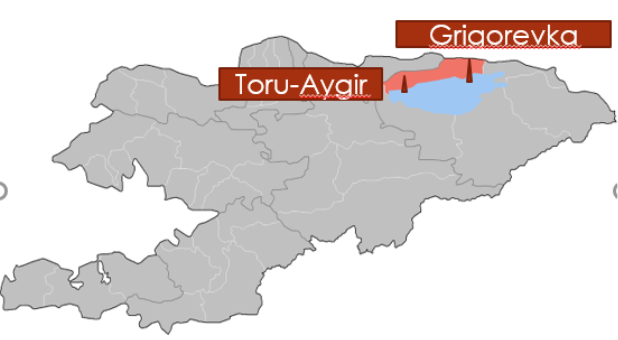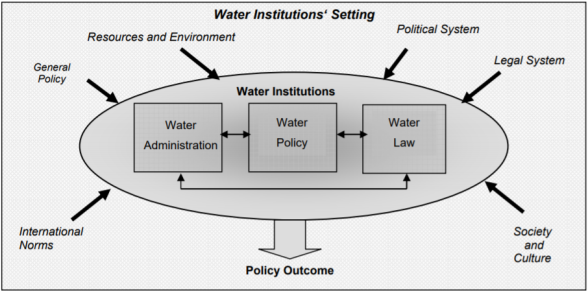The article deals with the problems of rational use of irrigation and return water. Also discusses the environmental situation in the region and public administration of water resources legal aspects, its main directions, water resources, water resources efficiency. The formation of governance discusses the issue of effective governance. Reflected questions of Water User Associations (WUA) in Kyrgyz Republic. Achievements WUA are shown under its development and problem-solving moments which suffer WUA and way of their decition.
INTRODUCTION
Issyk-Kul oblast is located in the north part of Kyrgyzstan. Its capital city is Karakol. Issyk-Kul is surrounded by Almaty Region, Kazakhstan from the north, Chuy Region from the west, Naryn Region from the southwest and Xinjiang, China from the southeast. Issyk-Kul takes its name from Lake Issyk-Kul which means «warm lake». This lake is world's second-largest high altitude lake. The lake surrounded by the ridges of the Tian Shan mountain system: the Kyungey Ala-Too mountains to the north and the Terskey Alatau to the south (the 'sunny' and 'shady' Alatau, respectively). To the south is mountains and 'jailoos' (mountain meadows used for summer grazing).
Kyrgyzstan is country in Central Asia where water resources are almost completely formed on it is own territory. It is hydrological future and big advantage. In spite of this here a lot of problems connected with water resource management. For Kyrgyzstan, which does not have significant natural resources, the question water policy is important because the established management practice water resources in the Central Asian region does not meet its interests. In Issyk-Kul region problem with water distribution have started after the collapse of Soviet Union. Now in this region there are around 20 villages. Where some of them has enough water for irrigation but other one has only limited access to water for irrigation. At the head of the village is Ayil Okmotu. Aiyl Okmotu (village council) — an executive and administrative body under a strong (rural) or settlement kenesh, which manages the affairs of life support and the life activities of the local community within the limits of its powers.
1.1 Geographical location
The Toru-Aygyr River basin is located in the Issyk-Kul basin. In the north-east of Kyrgyzstan, among the powerful mountain ranges that form the Northern and Central Tien Shan, there is a huge basin of Lake Issyk-Kul, sometimes called the Kyrgyz Sea for its size. The length of the river is 19 km. It is lost 2 km south of the village of Toru-Aygyr. The closeness of the region, its elevation, the presence of a deep-water vast reservoir creates a great peculiarity of climatic conditions. Summer is warm. The average temperature in July on the coastal plain ranges from 16.5°-17.5°. Winter is mild. Average January temperatures—2.2°-10.7°. In the west of the Issyk-Kul region, there is almost no snow, while in the east there is a lot of snow and it stays stable all winter. Therefore, to the east, the vegetation becomes richer. Changes in climatic conditions should also be noted in accordance with the general law of vertical zoning — elevation. The climate of the region can be described as temperate continental. Maximum precipitation falls in the foothills in the spring, in April-May. As the spring maximum rises, it shifts to later months. For example, at the Balykchy weather station, the maximum precipitation is observed in July.
Precipitation play one of the main role of the formation of the river. According to the Hydrometcenter of Russia created the table 1 the monthly and annual precipitation (mm), with corrections for wetting according to MS Balykchy. According to Table 1, a graph of the monthly precipitation on the MS Balykchy is plotted.
Table 1
Monthly and annual precipitation (mm), adjusted for wetting at MS Balykchy
|
1 |
2 |
3 |
4 |
5 |
6 |
7 |
8 |
9 |
10 |
11 |
12 |
YEAR |
|
0,7 |
0,6 |
2 |
10 |
20 |
28 |
29 |
21 |
10 |
4 |
1 |
0,4 |
127 |
This data is from 2015. It shows annual monthly and year precipitation. In this table we can see that the most precipitation comes to spring to early autumn 10 to 29 mm. Biggest amount of precipitation comes to July 29 mm. less precipitation comes to December 0,4 mm. Also created graph related to this data. As discussed earlier in the north-east part of Issyk-Kul there are few precipitation.

Fig. 1. Monthly and annual precipitation (precipitation, mm) in MS Balykchy
Grigoryevka is a village which located on the northern shore of Lake Issyk-Kul, at the foot of Kyungei-Ala-Too, one of the ridges of the Northern Tien Shan. The distance from Grigoryevka to the district center of the city of Cholpon-Ata is 34 km, to the regional center — Karakol — 109 km, to the capital of the republic — Bishkek — 295 km. According to the 2009 census, the village had a population of 5,133. The climate is characterized as temperate continental arid, with hot, dry summers and cold, snow-free winters. The average annual precipitation is 363 mm. The average temperature in January is -13.4 °C, in July — +21.4 °C.

Fig. 2. Map of the Kyrgyz Republic

Fig. 3. Map of the location of Tory-Aigyr and Grigorevka villages
1.2 Recourse of water in Issyk-kul region
In the Issyk-Kul region, 244 thousand m3 of river flow per 1 km2, and if we take separately the Issyk-Kul basin, where almost the entire population of the region lives, the river flow resources are only 10 thousand m3. (Choduraev, 2002). The surface water resources of the Tory-Aygyr district are constituted by the basins of the Tory-Aygyr river which flows from the Kungey mountains. The river has a well-defined channel and is fed by precipitation from its catchment area. The Chon-Ak-Suu River carries along the bottom of the gorge from the glaciers of the mighty Terskey Ala-Too ridge and it flows into Lake Issyk-Kul of the Kyrgyz Republic.
1.3 Problems connected with water for irrigations
For this research was chosen 2 different villages. The first village suffers from a lack of water for irrigation. Another village is rich in water resources. In Tory-Aygir village there are lack of drinking water and water for irrigation. Farmers have to wait their turn to access to water. Unfortunately, in most cases the crop dries up. To get drinking water same issue. People have access only one hour to filled out their bottles. And these are big problems for this region. Solving these kind of problems are not easy work. Another problem is geographical issue. Village is located far from the mountains and there is less precipitation than in Grigorevka. It is possible that the rules for the distribution of water are not followed.
Water institutions in Kyrgyzstan
In Kyrgyzstan there are different formal and informal institutions. Formal institutions play main role on decision making such as: The Ministry for Agriculture, Food Security and Land Reclamation of the Kyrgyz Republic, State Agency for Water Resources at the Government of the Kyrgyz Republic, Hydrometeorological Agency at the Ministry of Emergencies of the Kyrgyz Republic (Kyrgyzgidromet). Under the State Agency for Water Resources at the Government of the Kyrgyz Republic there are regional institutions in each oblast which manage locally. For Issyk-Kul region is Issyk-Kul Basin Water Management Administration. The Issyk-Kul Basin Water Management Administration (BWMA) is one of the structural units of the Department of Water Management and Land Reclamation. BWMA ensures the performance of the function of the state management and regulation body for water reserves (excluding therapeutic mineral and thermal waters), forms and implements a unified technical policy in the field of design, construction and operation of water management systems and facilities with a complex of regulatory and other devices and facilities designed for water use. Another concept is Water User Associations. It is a democratic organization. Water Users themselves at decentralized level, independent from state structures. It finances itself with members’ payments for the service of water delivery. Its main tasks are the maintenance of the tertiary irrigation system; the operation of this system, i.e. the distribution of the water obtained by the district water agency to the member farms in an equitable manner; and the collection of ISF from its members. Due to the accountability of the democratically elected board towards the members — the farmers — equitable water distribution should be guaranteed. [3] in Kyrgyzstan WUAs were introduced in 1994. It means that Kyrgyzstan was the first country where introduced this concept. According to the regulations, WUAs are responsible for the implementation of measures against land degradation, in addition to their tasks related to irrigation infrastructure. WUA work is based on a member-based decision-making body, which elects a board to serve as executive body. Members can be individuals, commercial organisations, or farms registered with various legal statuses. However, in many cases users do not actually hold decisionmaking power (Abdullaev et al., 2010). In Kyrgyzstan, for example, where several international organisations are responsible for the establishment and implementation of WUAs, the law does not clearly define the different institutions’ functions. This results in lack of uniform standards, as various donors bring different approaches to implementation (Roudik, 2013).

Fig. 4. Water Institutions Setting: Source from Jenniver Sehring (2006)
According to the article “Water user associations in Uzbekistan and Kyrgyzstan: study on conditions for sustainable development” the collected data of ten village-based WUAs are compared and analysed. The villages are in four different oblasts, in Osh & Jalalabad in the southern part and in Chui and Issy-Kul in the northern part of the Republic. Last but not least the Johnson report is based on data collected in four villages: in Uzyn-Kyr and Milyan-fan in Chui oblast, Toru-Aigyr in Issy-Kul oblast and Toolos-Nuakat in Osh oblast. (Johnson, p.5). By 2000 in Issy-Kul established 7 WUAs in 11.400 ha.
UNEQUAL WATER DISTRIBUTION
There are two general approaches to water distribution. One of them is based on the «rights» criterion. Most claims to water rights are based either on the principle of hydrography, where the main criterion is the territory of the formation of a river or aquifer, and also considers how much of this territory is located within the borders of a single state, or on the principle of chronology of water use, when it considers who has used water the longest historically. (Wolf) The second approach is based on the economic principle of efficient use. In this case, a distinction is made between efficiency and fairness (equity).The economic principle of efficiency assumes that the value of water for users in a particular basin is different, so the management of water resources should be such as to increase the overall efficiency of water use in accordance with these different criteria of water value. Just by itself, this principle, as a rule, is not perceived by the participants by the parties as fair.
As we know in Central Asia Kyrgyzstan and Tajikistan have power on water recourses because of high mountains. Kyrgyzstan is only country in Central Asia whose water resources are almost completely formed on it is own territory. It is hydrological future and big advantage. Despite this the problem of water resource distribution always exists. Around 1300 villages in Kyrgyzstan have limitation access to irrigation water. Same problem exists in Tory-Aygyr village due to different reasons. During the interview with few farmers and water community representative received answers that limitation access because of list of issues: 1) geographical location-far from mountains 2) climate change-less precipitation 3) using old traditional water distribution methods 4) corruption etc. Water policy should be stable. In our country very often changes governmental stuff. Local government should reduce corruption. Sometimes people can pay doubled fee to get accesses to water first. Another problem is geographical issue. Village is located far from the mountains and there is less precipitation than in Grigorevka.
Among these problems corruption is big issue for equal water distribution which existing through the years. According to the article “Corruption in Public Service Delivery: Experience from South Asia’s Water and Sanitation Sector” The range of corrupt behaviors in water supply and sanitation service delivery outlined in this paper is likely not surprising to professionals familiar with public institutions in South Asia; however, the sophistication and pervasiveness of the exchange systems could well discourage those interested in initiating reforms to boost transparency and reduce rent seeking in W&S services. Indeed, one understands why leadership in the institutions we studied uniformly chose to avoid direct discussion, much less confrontation, of these issues. At the same time, it is encouraging that even in this challenging operational environment we documented several strategies that do appear to have reduced corruption in service delivery. Among these, every one shared two drivers: one which altered accountability networks in service provision, and one which changed the attitudes of service providers in a way that increased the moral cost to them of misconduct.
The main cause of water problems is anthropogenic factors, both objective, caused by the development of irrigation, and subjective, caused by the irrational use of water resources. In Kyrgyzstan, there is a full range of problems related to water, as well as its distribution. Such problems can lead to tense and conflicting circumstances, even within a single village. To improve this situation in Kyrgyzstan and in the regions, it is necessary: reuse of wastewater in industry, in recycling systems; economical use of water in industries agriculture; combating water losses during transportation to irrigation fields by creating modern channels with anti-filtration coatings; stopping the discharge of polluted wastewater into reservoirs; improving water resources management and distribution; improvement of the water resources monitoring system; strengthening the material, technical and financial base; ensuring an effective legislative framework.
References:
- Чодураев, Т. М. (2002) Ohrana I racionalnoye ispolzovaniye vodnyh resursov Kirgizstana [Protection and rational use of water resources in Kyrgyzstan]. Reforma, 1(13), 17–23.
- Meteorologiya I gidrologiya v Kirgizstane [Meteorology and Hydrology in Kyrgyzsran] (ed. 2)-О. А. Подрезов, Бишкек 2002–64с.
- Sehring, J. (2006, November). The politics of water institutional reform. A comparative analysis of Kyrgyzstan and Tajikistan. In Conference on Human Dimensions of Global Environmental Change.
- Water Code of Kyrgyz Republic
- Россгидрометцентр- https://meteoinfo.ru/
- Wolf, Aaron. Criteria for equitable allocations: The heart of international water conflict, Natural Resources Forum, Vol. 23 #1, February 1999. pp. 3–30. Retrieved from:
- Abdullaev, I., Kazbekov, J., Manthritilake, H., & Jumaboev, K. (2010). Water user groups in Central Asia: emerging form of collective action in irrigation water management. Water resources management, 24(5), 1029–1043.
- Roudik, P. (2013). The Nakaz of Catherine the Great: Collected texts. International Journal of Legal Information, 41(3), 394.
- Мусабаева, А. (2007). Водная политика Кыргызстана: вызовы и возможные шаги их преодоления.
- Davis, J. (2004). Corruption in public service delivery: experience from South Asia’s water and sanitation sector. World development, 32(1), 53–71.
- Hassing, J. (2009). Integrated water resources management in action: dialogue paper. Unesco.
- Мирзаев, Н. Н. (2010). Интегрированное управление водными ресурсами (институциональные аспекты). НИЦ МКВК, Проект «ИУВ-Фергана», Ташкент.
- Иванова, Н. И., Аскаралиев, Б. О., Фролова, Г. П., & Биленко, В. А. (2005). Проблемы управления водными ресурсами на оросительных системах Кыргызстана в условиях рыночной экономики. In Фундаментальные проблемы изучения и использования воды и водных ресурсов: материалы научной конференции.-Иркутск: Изд-во Института Географии СО РАН.
- Hodgson, G. M. What are Institutions? J. Econ. Issues 2006, XL, 1–25.
- Brusseau, E.; Garrouste, P.; Raynaud, E. Institutional changes: Alternative theories and consequences for institutional design. J. Econ. Behav. Organ. 2011, 79, 3–19.
- Zwarteveen, M., Kemerink‐Seyoum, J. S., Kooy, M., Evers, J., Guerrero, T. A., Batubara, B.,... & Cuadrado‐Quesada, G. (2017). Engaging with the politics of water governance. Wiley Interdisciplinary Reviews: Water, 4(6), e1245.
- Nixon, R., & Owusu, F. (2017). Choice, inclusion, and access to information: Understanding female farmers’ participation in Kyrgyzstan’s water-user associations. Sustainability, 9(12), 2346.
- Kazbekov, J., Abdullaev, I., Manthrithilake, H., Qureshi, A., & Jumaboev, K. (2009). Evaluating planning and delivery performance of water user associations (WUAs) in Osh Province, Kyrgyzstan. Agricultural water management, 96(8), 1259–1267.
- Rost, K. T., Ratfelder, G., & Topbaev, O. (2015). Problems of rural drinking water supply management in Central Kyrgyzstan: a case study from Kara-Suu village, Naryn Oblast. Environmental earth sciences, 73(2), 863–872.
- Sehring, J. (2007). Irrigation reform in Kyrgyzstan and Tajikistan. Irrigation and Drainage Systems, 21(3–4), 277–290.
- Zwarteveen, M., Kemerink‐Seyoum, J. S., Kooy, M., Evers, J., Guerrero, T. A., Batubara, B.,... & Cuadrado‐Quesada, G. (2017). Engaging with the politics of water governance. Wiley Interdisciplinary Reviews: Water, 4(6), e1245.
- Nixon, R., & Owusu, F. (2017). Choice, inclusion, and access to information: Understanding female farmers’ participation in Kyrgyzstan’s water-user associations. Sustainability, 9(12), 2346.
- Kazbekov, J., Abdullaev, I., Manthrithilake, H., Qureshi, A., & Jumaboev, K. (2009). Evaluating planning and delivery performance of water user associations (WUAs) in Osh Province, Kyrgyzstan. Agricultural water management, 96(8), 1259–1267.
- Rost, K. T., Ratfelder, G., & Topbaev, O. (2015). Problems of rural drinking water supply management in Central Kyrgyzstan: a case study from Kara-Suu village, Naryn Oblast. Environmental earth sciences, 73(2), 863–872.







